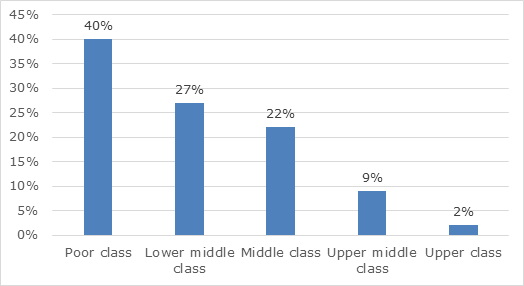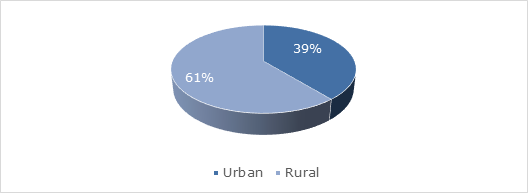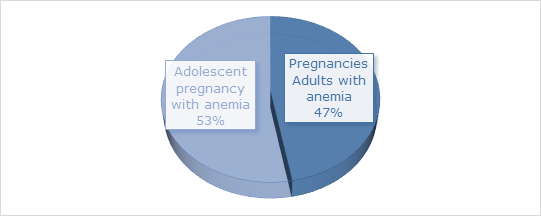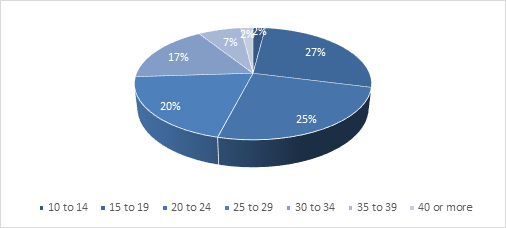Mi SciELO
Servicios Personalizados
Articulo
Indicadores
-
 Citado por SciELO
Citado por SciELO
Links relacionados
-
 Similares en
SciELO
Similares en
SciELO
Compartir
Revista de Ciencias Médicas de Pinar del Río
versión On-line ISSN 1561-3194
Rev Ciencias Médicas vol.27 supl.1 Pinar del Río 2023 Epub 01-Jul-2023
Articles
Social and demographic characteristics of pregnant women with anemia in Ecuador in 2018
1Universidad Regional Autónoma de Los Andes. Ibarra, Ecuador
ABSTRACT Introduction: anemia is one of the most common deficiency diseases worldwide, affecting mainly children and pregnant women. It usually occurs during pregnancy as a physiological process; however, in the presence of previous deficiency situations it intensifies, affecting the course of the pregnancy. Objective: to characterize the sociodemographic factors of pregnant women with anemia in Ecuador in 2018. Methods: an observational, descriptive, cross-sectional study was conducted in pregnant women with anemia in Ecuador during 2018. The portal of the National Institute of Statistics and Census (INEC), the Ministry of Public Health (MSP) and the 2018 National Health and Nutrition Survey were used to obtain the information. The downloaded data were curated to extract the results of interest for the study. Results: approximately 22,3 % of pregnant women had anemia, where 40 % belonged to the low incomes class (n=27 294) and 61 % resided in rural area. Fifty-three percent of pregnant women with anemia were adolescents; with respect to age groups, 27 % of pregnant women with anemia were between 10 and 14 years of age. Conclusions: in Ecuador, in 2018 there was a high prevalence of anemia in pregnancy, where adolescent pregnant women, those living in rural areas and those with lower purchasing power had a higher prevalence.
Key words: PREGNANCY; ANEMIA; ECUADOR; CARENTIAL DISEASES; SOCIODEMOGRAPHIC FACTORS.
INTRODUCTION
Iron deficiency constitutes one of the most common macronutrient deficiencies, affecting almost one third of the world's population. This deficit generally causes microcytic anemia, which manifests with fatigue, weakness, dyspnea and exhaustion.1,2
According to the World Health Organization (WHO), the state of hemoglobin levels falling two standard deviations below the normal reference values for age and sex is defined as anemia. This represents a serious public health problem, affecting vulnerable populations such as children between six and 59 months (20 %), 30 % of women between 15 and 49 years of age and 37 % of pregnant women.3
According to the Global Burden of Disease Study 2019,4 which studied the factors and incidence of anemia in 204 countries according to data from 1990-2019, in 2019 there were approximately 1,8 billion cases of anemia in the world, with a prevalence of 23176,2 per 100000 people, 13,4 % lower than in 1990. The region with the highest recorded prevalence was South Asia (41646,1 per 100000 people) and Sub-Saharan Africa (40977 per 100000 people); the country with the highest prevalence was Zambia (49327 cases per 100000 people). The study concluded that, despite the multiple etiologies of anemia, deficient iron intake remains the main cause, hence the need for strategies to achieve prevention through treatment of vulnerable groups such as children and women of reproductive age.
A study developed to determine the prevalence and factors associated with anemia in women of reproductive age in Africa found a prevalence of 34,85 % (95 %CI: 34,56-35,14).5
The total fertility rate in Latin America and the Caribbean varies among countries. Bolivia has a rate of 2,8, Peru 2,3 and Ecuador 2,2; other countries report lower rates such as Colombia (1,8) and Chile (1,7). Between 1989 and 2018, a downward trend in this rate has been observed in Ecuador, from 3,8 to 2,2.6)
Pregnancy as a physiological process in women represents a group of changes in the functioning of the organism at the physical and psychological level, which alters the internal dynamics of the organism. The female body must change to meet the demand of having a new being inside her. Although these changes are gradual, multiple factors, such as previous illnesses or predisposing conditions, can alter this process, leading to unplanned situations.7
Although the cessation of menstruation during the gestational period produces a decrease in iron requirements during the first trimester, in the second trimester this increases again, due to an increase in maternal erythrocytosis, accelerated placental and fetal growth.8
Although there are regulatory mechanisms to deal with this situation, in the pregnant woman, due to a process similar to hemodilution, there is a physiological decrease in hemoglobin concentrations. This is a phenomenon secondary to a large increase in plasma volume, which triggers a decrease of approximately 2-3 g/dL of hemoglobin. In the presence of a previous iron deficiency, this situation leads to iron deficiency anemia.8
The present study was developed with the aim of characterizing the sociodemographic factors of pregnant women with anemia in Ecuador.
METHODS
An observational, descriptive, cross-sectional study was conducted on the sociodemographic factors of pregnant women with anemia in Ecuador during 2018. The research took as study population the total number of pregnant women with anemia in Ecuador during 2018.
To obtain the information, statistics provided in the portal of the National Institute of Statistics and Census (INEC) (https://www.ecuadorencifras.gob.ec/institucional/home/), the Ministry of Public Health (MSP) (https://www.salud.gob.ec/) and micro data from the 2018 National Health and Nutrition Survey (https://anda.inec.gob.ec/anda/index.php/catalog/891/get_microdata) were used.
The downloaded data were curated to extract the results of interest for the study. With the final data, we proceeded to perform a descriptive statistical analysis by calculating absolute and relative percentage frequencies.
As this was a study developed from public data, it was not necessary to request approval by an ethics committee or scientific board. The data are used for academic purposes only.
RESULTSFigure 3
Of the 305979 pregnant women reported in INEC and MSP statistics in 2018, approximately 22,3 % (n=68233) had anemia. Forty percent of pregnant women with anemia belonged to the poor (low-income) class (n=27 294) (Figure 1).
Regarding demographic status, 61 % of the patients resided in rural areas (Figure 2).
Regarding age groups, 27 % of pregnant women with anemia were between 10 and 14 years of age, and 25 % were between 15 and 19 years of age (Figure 4).
DISCUSSION
A predominance of pregnant women with anemia was identified in the low-income group, which is defined as the predominant group in the current society of the country. This population is consequently linked to suffer needs especially in the health area, due to the lack of necessary medical implements and medicine to treat anemia in pregnant women.
According to the study by Safiri et al.,4 the socioeconomic factor is a determinant in the incidence and prevalence of anemia, where inverse associations have been established between income and the presence of anemia; hence, better income is generally expressed in a lower probability of suffering from anemia. This is understandable, since anemia is mostly triggered by nutritional deficits.
In addition, the existing demographic situation in our country limits pregnant women with anemia to have timely care, since most low-income women are present in the countryside. The deficiency of the public health system in the rural areas restricts women to have a line of control of their health and that of their babies, increasing the possible subsequent diseases.
It has been considered that the area of residence is a factor that has an impact on health. There are several elements that speak in favor of residing in urban areas to present a lower risk of anemia, which can be direct or indirect.9 Regarding socioeconomic factors, it is stated that in urban areas there is a greater availability of jobs, which has a direct impact on the economy. With respect to sanitary factors, it is stated that in urban areas there is greater availability and variety of health and family planning services, as well as better sanitation of water for consumption and systems for the elimination of waste products. All of these elements were found to be protective factors against anemia during pregnancy.10
If this information is contrasted with data from the ENSANUT 2018,6 only in the indicator of access to health services, the number of mothers who received at least five prenatal checkups was lower in the rural area compared to the urban area (75,7 % vs. 87 %). Several elements may be involved in this result, such as, for example, the socio-cultural level of the people, the family economy and the risk perception of the pregnant women.
A five-year study by Ampiah et al.11 found a higher prevalence of anemia in adolescent pregnant women compared to adult pregnant women, ranging between 70 % and 80 % in adolescent pregnant women and between 55 % and 70 % in adult pregnant women, finding a statistically significant relationship between gestational age and the presence of anemia (p<0,05).
This result may be determined by several elements, however, the authors consider it necessary to highlight the role of the lack of preparation or immaturity of the adolescent's body to face pregnancy, which brings about inefficient or not adapted compensation mechanisms and therefore a higher risk of suffering anemia during gestation.12,13,14
The average age at first birth in Ecuador is 21 years.6 Similarly, in Ecuador, higher percentages of births have been reported in the age groups 20 to 24 years (27 %), 25 to 29 years (23,5 %), followed by pregnant women between 15 and 19 years (18,8 %) and 30 to 34 years (17,4 %).15 Similar results were found in the present study regarding the age of pregnant women with anemia.
A study conducted by Cerón Martínez et al.16 in 39 pregnant women with anemia found that 66,67 % were between 21 and 35 years of age, similar to the present study, although the cited study found a lower percentage in the 14 to 20 years age group (15,38 %) than the present one.
The education of women is intimately linked to the care of them during their gestation periods, the lack of knowledge of these diseases means that the proper precautions are not taken to avoid this problem, especially anemia in mothers and children.17
One of the main problems faced by the Health System is the increase in pregnancies, especially in adolescents. Pregnant women in this group are not aware of the responsibility involved in having a child at an early age, as well as the risks involved.
To alleviate this situation, one of the strategies adopted by the government of the Republic of Ecuador is the timely care of people through its public health network, which through campaigns has promoted the supplementation of micronutrients for children, pregnant and nursing mothers, receiving iron supplements, multivitamins, mineral powder, vitamin A, iron and folic acid. This action is part of the Integrated Micronutrient Program, in order to contribute to the reduction of the main deficiencies and prevent anemia, since micronutrients are necessary elements in the daily diet of this population group.
It is concluded that, in Ecuador, in 2018 there was a high prevalence of anemia in pregnancy, where adolescent pregnant women, those residing in rural areas and those with lower purchasing power presented higher prevalence.
BIBLIOGRAPHIC REFERENCES
1. Pérez Conforme H, Ponce Plúa J, Pilay Vargas L, Veliz Castro T. Valores de hemoglobina y hematocrito y su asociación a determinantes de déficit de nutrientes en niños de la Parroquia Machalilla en Puerto López - Ecuador. Rev Investig y Educ en Salud [Internet]. 2022 [citado 11/12/2022]; 1(1):4-14. Disponible en: Disponible en: https://revistas.unesum.edu.ec/salud/index.php/revista/article/view/1 1. [ Links ]
2. Han X, Ding S, Lu J, Li Y. Global, regional, and national burdens of common micronutrient deficiencies from 1990 to 2019: A secondary trend analysis based on the Global Burden of Disease 2019 study. eClinicalMedicine [Internet]. 2022 [citado 11/12/2022]; 44:101299. Disponible en: Disponible en: https://linkinghub.elsevier.com/retrieve/pii/S2589537022000293 2. [ Links ]
3. Organización Mundial de la Salud. Anemia [Internet]. Ginebra, Suiza: Organización Mundial de la Salud; 2022 [citado 11/12/2022]. Disponible en: https://www.who.int/es/health-topics/anaemia#tab=tab_1 [ Links ]
4. Safiri S, Kolahi A-A, Noori M, Nejadghaderi SA, Karamzad N, Bragazzi NL, et al. Burden of anemia and its underlying causes in 204 countries and territories, 1990-2019: results from the Global Burden of Disease Study 2019. J Hematol Oncol [Internet]. 2021 [citado 11/12/2022]; 14(1):185. Disponible en: Disponible en: https://jhoonline.biomedcentral.com/articles/10.1186/s13045-021-01202-2 4. [ Links ]
5. Teshale AB, Tesema GA, Worku MG, Yeshaw Y, Tessema ZT. Anemia and its associated factors among women of reproductive age in eastern Africa: A multilevel mixed-effects generalized linear model. Spradley FT, editor. PLoS One [Internet]. 2020 [citado 11/12/2022]; 15(9):e0238957. Disponible en: Disponible en: https://dx.plos.org/10.1371/journal.pone.0238957 5. [ Links ]
6. Instituto Nacional de Estadística y Censos (INEC). Encuesta Nacional de Salud y Nutrición - ENSANUT 2018. Quito, Ecuador; 2018 [citado 11/12/2022]. Disponible en: https://www.ecuadorencifras.gob.ec/documentos/web-inec/Estadisticas_Sociales/ENSANUT/ENSANUT_2018/Principales%20resultados%20ENSANUT_2018.pdf [ Links ]
7. Carrillo-Mora P, García-Franco A, Soto-Lara M, Rodríguez-Vásquez G, Pérez-Villalobos J, Martínez-Torres D. Cambios fisiológicos durante el embarazo normal. Rev la Fac Med [Internet]. 2021 [citado 11/12/2022]; 64(1):39-48. Disponible en: Disponible en: http://revistafacmed.com/index.php?option=com_phocadownload&view=file&id=1379:cambios-fisiolgicos-durante-el-embarazo&Itemid=79 7. [ Links ]
8. Churchill D, Nair M, Stanworth SJ, Knight M. The change in haemoglobin concentration between the first and third trimesters of pregnancy: a population study. BMC Pregnancy Childbirth [Internet]. 2019 [citado 11/12/2022]; 19(1):359. Disponible en: Disponible en: https://bmcpregnancychildbirth.biomedcentral.com/articles/10.1186/s12884-019-2495-0 8. [ Links ]
9. Flores-García M, Cruz-Santiago H, García-Baltazar JA, Torres-Olivera MA, Ramírez-Figueroa AD, Ávila-Serrano NY, et al. Preconception diet and its relationship with hemoglobin in rural and urban women of San Francisco Cozoaltepec and Puerto Escondido, Oaxaca. Salud, Ciencia y Tecnología [Internet]. 2023 [citado 05/04/2023]; 3:259. Disponible en: Disponible en: https://revista.saludcyt.ar/ojs/index.php/sct/article/view/259 9. [ Links ]
10. Owais A, Merritt C, Lee C, Bhutta ZA. Anemia among Women of Reproductive Age: An Overview of Global Burden, Trends, Determinants, and Drivers of Progress in Low- and Middle-Income Countries. Nutrients [Internet]. 2021 [citado 11/12/2022]; 13(8):2745. Disponible en: Disponible en: https://www.mdpi.com/2072-6643/13/8/2745 10. [ Links ]
11. Ampiah MKM, Kovey JJ, Apprey C, Annan RA. Comparative analysis of trends and determinants of anaemia between adult and teenage pregnant women in two rural districts of Ghana. BMC Public Health [Internet]. 2019 [citado 11/12/2022]; 19(1):1379. Disponible en: Disponible en: https://bmcpublichealth.biomedcentral.com/articles/10.1186/s12889-019-7603-6 11. [ Links ]
12. Robaina-Castillo JI, Hernández-García F, Ruiz Gómez L. Consideraciones actuales sobre el embarazo en la adolescencia. Univ Médica Pinareña [Internet]. 2019 [citado 11/12/2022]; 15(1):123-33. Disponible en: Disponible en: http://www.revgaleno.sld.cu/index.php/ump/article/view/331 12. [ Links ]
13. Blacio Rivas A, Eras Carranza J, Floreano Solano L, Saraguro Salinas S, Arias Montero I, Escobar Blacio JA. Anemia en embarazadas atendidas en el hospital obstétrico Ángela Loayza de Ollague. Enfermería Investig Investig Vinculación Docencia y Gestión [Internet]. 2019 [citado 11/12/2022]; 4(1):33. Disponible en: Disponible en: http://revistas.uta.edu.ec/erevista/index.php/enfi/article/view/480 13. [ Links ]
14. Tixe Lluglla EA, Chalan Analuisa MC, Panimboza Guamán IP, Sanaguano Castillo JM, Escobar Castillo PR, Dután Ortiz FG, et al. Evidence for carbetocin in obstetric hemorrhage. Salud, Ciencia y Tecnología [Internet]. 2023 [citado 11/12/2022]; 3:341. Disponible en: Disponible en: https://revista.saludcyt.ar/ojs/index.php/sct/article/view/341 14. [ Links ]
15. Instituto Nacional de Estadística y Censos (INEC). Estadísticas Vitales. Registro Estadístico de Nacidos Vivos y Defunciones 2018 [Internet]. Quito, Ecuador; 2019 [citado 11/12/2022]. Disponible en: Disponible en: http://www.ecuadorencifras.gob.ec/nacimientos-defunciones/ 15. [ Links ]
16. Cerón Martínez VD, Pinde Niauñay KP. Anemia en el embarazo y complicaciones maternas y perinatales. Riobamba ,2019- 2020 [Tesis de pregrado]. Universidad Nacional De Chimborazo; 2020 [citado 11/12/2022]. Disponible en: Disponible en: http://dspace.unach.edu.ec/handle/51000/7696 16. [ Links ]
17. Romero Viamonte K, Vega Falcon V, Salvent Tames A, Sánchez Martínez B, Bolaños Vaca KJ. Factores de riesgo materno que retrasan el crecimiento intrauterino en gestantes adolescentes del Hospital General Docente Ambato, Ecuador. Rev Cuba Obstet y Ginecol [Internet]. 2020 [citado 11/12/2022]; 46(1):1-15. Disponible en: Disponible en: http://www.revginecobstetricia.sld.cu/index.php/gin/article/view/414 17. [ Links ]
Received: June 15, 2023; Accepted: August 08, 2023











 texto en
texto en 






